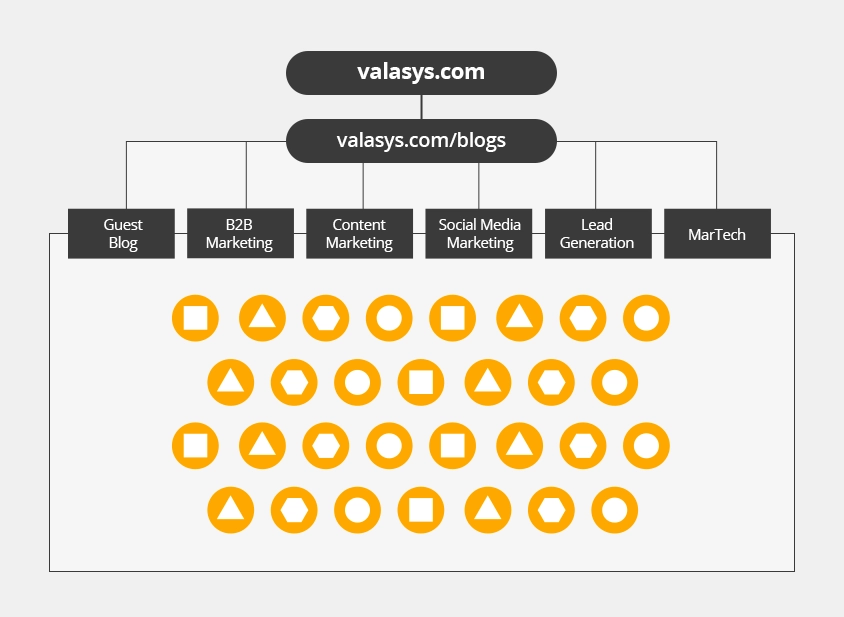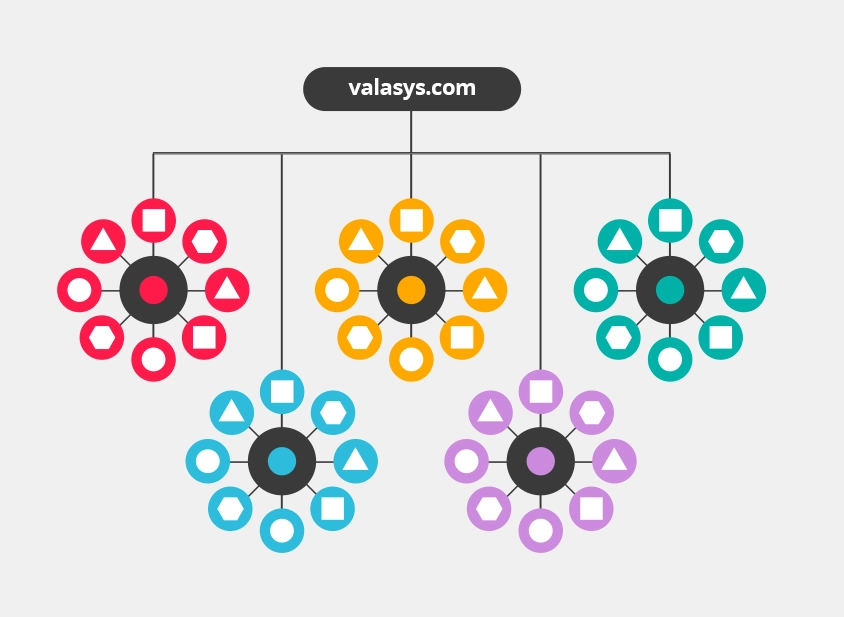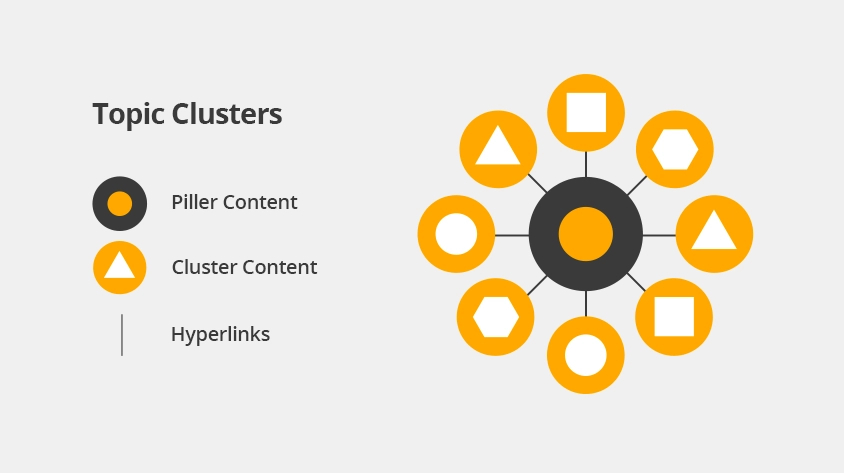What is Pillar Page Strategy how it helps SEO?

Table of Contents
- Changing Algorithms & Search Behaviors
- What are Pillar Pages?
- Why do you need a Pillar Page?
- How to create a Pillar Page?
- How does Pillar Page impact your SEO?
- Type of Pillar Pages:
- Ideal length of Pillar Page & Cluster Content:
- Summary:
Changing Algorithms & Search Behaviors
Change is the only constant in the field of digital marketing. This field is evolving at such a rate that a trend today becomes obsolete tomorrow. Marketing sector packs a powerful punch the moment you think you have figured out what it’s all about. Staying on your toes and flexible is the golden rule every marketer will vouch for.
Take for example Search Engine Optimization (SEO). From Panda, launched on 24th February 2011 to Core Web Vitals, each update had its strategies to help optimize your blog to rank at the top of Search Engine Result Pages (SERPs). Each algorithm came with its own set of SEO rules to help rank your web pages better.
But why change search engine algorithms at all? Because search behavior of users are changing. To curate tailored search results for better efficiency, search engines had to upgrade. Imagine how difficult it would be to find a relevant content in the 99th page of Google. That’s why the updates & upgrades.
Panda, one of the earliest Google algorithms enabled the search engines to assign a “quality score” to webpages on basis of duplication, plagiarism, keyword stuffing, and user-generated spam. This feature has since been adapted into Google’s core algorithm.
Then came Penguin. This updated algorithm would strictly monitor the backlinks, spammy links, and exaggerated anchor texts and would rank down the websites where the links look unnatural. Post which Hummingbird was launched to ensure readers and users get relevant and quality content and leveraged natural language processing techniques that rely on latent semantic indexing, synonyms, and closely-related words. Hummingbird update helped search engines to understand the context of the content as a whole rather than just rely on a single keyword.
With each new update, search engines are getting better, more efficient, and smarter. Producing results tailored to the needs of the users.
The current algorithm search engines are employing is the Core Web Vitals. Google and other search engines have not clearly defined what they are looking for in a blog or a webpage now to rank them higher. At Valasys Media, our team of digital marketing experts ran a survey of over 1000+ blogs to track and monitor how the rankings are changing with respect to a competitor. In doing such a comparative analysis, we figured that your webpage architecture or your blog structure may have a role to play in ranking your websites. Just optimizing your content for a long-tail keyword is not enough. Something else is in play here too. And we think Pillar Page strategies may have a significant role to play here.
What are Pillar Pages?
Before we get into the nitty gritty of a Pillar Page and understand how it helps your current SEO algorithm, we must tackle the concept of Topic Clusters. Our very own blog section utilizes the concept of Topic Clusters. As the name suggests, it is the clustering of blogs with similar subtopics or categories. But cluster topics when we can put up individual blogs ranking each keyword specifically? Well, there are threefold reasons why the Topic Cluster model works.
1. Search queries are becoming more conversational and long as opposed to a single word.
Imagine this, if you are trying to buy a new pair of shoes for your new black year gown, would you rather search “shoes” or “shoes for black gown”? There is a staggering increase in search queries with four or more words. Why? Number one, because more and more voice searches are replacing the traditional “Type and search” options. And number two, because these long tail searches are more specific.
2. Users are browsing through a lot more content than before.
Not only the users are spending more time on the internet but are also able to browse through a mammoth amount of content in a span of seconds. This is because users can make a gist out of the blog at times by just reading the headlines. This is why search engines are also getting better at sorting stuff and serving users with the most accurate search results.
3. Parallel search results.
With search engines getting better at Latent Semantic Indexing, have you ever experienced getting results for something more than you searched for as if you and your device share a telepathic connection? And no, it is not AI taking over your life or you are a mutant waiting to get into Xavier’s school. It is Google doing Google things. Search engines are adapting to provide users with accurate results even if the search query is not that accurate. Try searching for earphones with cable, and search results might prompt you to get a splitter as well. You can use this feature of search engines to prompt the product you want.
Topic Cluster is what you all need.
Topic Clusters are a great way to boost your web pages and overall website. This is the way most websites including ours organize content on their website. As opposed to topic clusters, creating individual blog posts to rank for specific keywords results in disorganization and a haphazard way of putting up content. By doing so, your own URLs compete against each other, and it becomes difficult to find and navigate their way to the desired content or blog. Topic clusters not only help in eliminating these difficulties but also creates a broader search authority. By hyperlinking all the related topics of a specific keyword in a bundle, you improve blog reusability, navigation, and overall infrastructure of your blog architecture. With the URLs all linked to one another in a cluster, it is easy for the users to navigate from one related topic to another.
This is how disorganized blog structure of individual blog post looks like:
And this is how structured, and organized Topic Clusters look like:
Each node here represents a Pillar Content hyperlinked to various cluster contents.
A Pillar Node can be represented as:
There are 3 components to such a model.
- A Pillar Content
- Cluster Contents
- Hyperlinks
A Pillar Content is generally a webpage targeting one single broad keyword. It is usually longer than the average blog post as it addresses a wider and broader topic. Within it, are various subtopics These subtopics can be your Cluster Content targeting various related secondary & tertiary keywords. Derived from the primary keyword of the Pillar Content. Cluster contents are your typical blogs. Delving into the specifics of the subcategories providing greater details and insights into the topic. And finally, Hyperlinks, linking each subcategory to the Pillar Content to complete the circle.
For example, your Pillar Content Page can be Digital Marketing, a broad and general keyword. It can list all the different aspects of digital marketing including 5Ws and 1H. Whereas your Cluster content can dive deep into each subcategory like Content Marketing, Social Media Marketing. Affiliate Marketing, SEO, and so on You can create sub-clusters among the cluster contents. If you have additional information and related resources . Finally, inter-link these blogs at various instances, enabling the traffic to navigate. From one topic to another as and when they feel like it, thereby. Keeping the user within the ecosystem of keywords and blogs you have created.
So, what is a Pillar Page?
A pillar page is centered around one primary keyword based on which the cluster contents are built. A pillar page typically encompasses all the aspects of a particular topic or keyword and is more generic in nature with space for detailed content to be uploaded with subsequent cluster contents. While you answer various questions centered around your pillar keyword, you leave room for subsequent and related cluster contents. You can consider it as the parent page with basic info about all its offspring and the cluster contents are the offspring of the pillar page.
Why do you need a Pillar Page?
There are several utilities for structuring a pillar page:
Higher SEO Ranking: With blog topics arranged in clusters centering around a certain keyword and its subsequent related secondary keywords, search engines will rank your content better.
Easy Navigation: Internal redirections within the blog posts allow users to navigate from one blog topic to another with relative ease. This internal redirection within your website will also help reduce bounce rates as traffic keeps. navigating from one topic to another within the same ecosystem you have created for a keyword. Also, by clustering blog topics of similar keywords or related themes. it is easier for a user to search for a keyword and find the accurate and desired result.
Prevent competing against your URLs: By uploading individual blog posts, you often end up competing against your own URLs. By creating a network of similar topics, you prevent this from happening and help get the ranking of your Pillar page up.
Traffic distribution across multiple web pages: Say one of your blog posts is performing well. You can now redistribute this traffic across all your related blog themes and topics by clustering them in a bundle. The pillar page strategy model enables traffic distribution across multiple blog posts. Your high-performing blog post will act as a traffic magnet and the hyperlinks will redirect them to otherwise low-performing blogs as per usability.
Ease of sorting for search engines: Clustering contents under a pillar page help search engines to easily sort the webpages and curate tailored search results.
Recommendations: Imagine life without YouTube recommendations. Based on your search history and preferences, YouTube recommends videos that you might like. Pillar page and cluster content in a way work like that. The probability that a separate blog under the specified keyword might pop up in search results apart from the one already intended for.
How to create a Pillar Page strategy?
The first step towards creating a pillar page strategy is to consider your website as a collection of topics rather than individual keywords. Identify the topics you want your traffic to discover. Make sure the topic for your pillar page is broad & generic.
The next step would be to bifurcate the broad topic into smaller subcategories. Your pillar page topic must be broad enough to ensure you have numerous subcategories and interrelated themes to talk about. A narrow topic would have a smaller node. The bigger the node, the better.
Here is a thing to consider. Although your pillar page must be generic and broad, it must also address the basic queries for the keyword. For a better result, you must give more emphasis on ranking your pillar page higher than the individual cluster content, but this is not mandatory. The idea is, if you can rank your pillar page higher than the sum of the cluster contents, there is a possibility that in the long run, your cluster contents will perform better too. But even vice versa works just well.
Your pillar page needs to be conversational in tone so that you can lead the traffic to explore the details of the subcategories you have mentioned. A boring and monotonous pillar page will not fetch the required redirections you are looking for. Avoid exaggerated anchor text and keep it as simple and natural as possible.
And lastly, your pillar page needs to have a definite flow to your content. This will lead to traffic getting redirected at a healthy rate. Story-telling approaches can do wonders. Leave your readers with a cliffhanger moment that incites them to click on the link to know more about the related cluster content.
How does Pillar Page impact your SEO?
A pillar page adds a whole lot of benefits for SEO but the main reasons why you should a Pillar page to your website are:
1. Pillar pages make it easier for search engines to crawl your website. The quicker a search engine can crawl and index your website, the higher your content will rank for a given query.
2. Pillar pages can help readers and incoming traffic to fill in the informational gaps that might exist. Upon searching for a query on engines, you are prompted to a page specific to your query. But pillar pages help you expand your research to every aspect of that particular topic in a more organized way.
3. Improving site structure and the related links pointing to key content pillars.
4. Reduce bounce rates as the user will stay within the ecosystem of the pillar for a longer duration.
Type of Pillar Pages:
There are broadly three different categories or types of Pillars Page we can create:
- The “Guide” Pillar Page: These pillar pages serve as guides or 101 for a specified topic. A topic like “The Ultimate Guide to Digital Marketing” can form the basis of your pillar page. The other spinoff topics can then be added as cluster content to make it work. Make the blog post interactive and less spammy.
- The “What is” Pillar Page: These pillar pages are mostly query-based and offer a broad spectrum and a generic view of the topic leaving room for cluster contents. A topic like “What is Digital Marketing” can form the pillar page where you talk about the basics and the fundamentals of the topic and link each subtopic to a cluster of content for an in-depth analysis.
- The “How to” Pillar Page: These pillar pages are designed to give your readers specific directions as to how to do a specific thing. A topic like “How to start Digital Marketing” can form a pillar page under this type.
Ideal length of Pillar Page & Cluster Content:
Because the pillar pages tend to address broader topics, these need to be between 2000-3000 words giving your audience enough juice about the topic to be invested in. Although you do not want to go into detail for every topic on your pillar page and keep the space for detailed content within the clusters, it is important to address the queries that encompass every perspective for the chosen primary keywords. Ensuring your pillar page performs well will mean your cluster content performs well over the long run. And although there is no specified word limit for your pillar page, it is advisable your pillar page has enough meat, is interactive, and covers every aspect of the main topic. In comparison, your cluster contents can be shorter, crisper, more to the point, and specific.
Summary:
Pillar pages are a great way to organize a bundle of content both for the search engines and for the readers. There are tons of readily available templates for pillar pages online. But it is important to keep in mind, the structure of the pillar page is kept intact, niche-oriented. Connects all relevant topics, and interconnects all the associated keywords. Primary keyword If you have a ton of content on your website and are looking to organize. Them in a better way, Pillar page creation is the way to go about it. You can see the results for yourself Keeping in mind the current algorithm. search engines are employing, creating a sound Pillar Page may prove to be a lifesaver for your website and SEO rankings.




